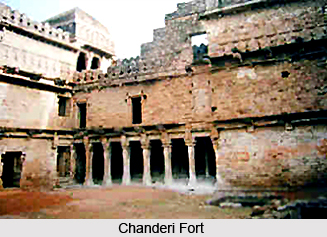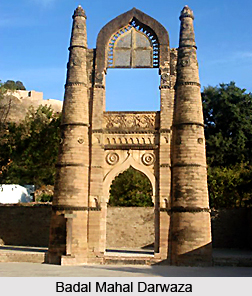 The monuments of Chanderi in Madhya Pradesh mirror the impact of Mughal style of architecture. Chanderi, 34 km west of Lalitpur, was once a town of considerable strategic importance, picturesquely sited in a great bay of sandstone hills pierced by narrow passes. It was the northern capital of Malwa, an independent dominion of the Muslim sultanate. In the early 16th century it was conferred on Medini Rao and then it was seized by Babur in 1528. The monuments of Chanderi date from the 4th Century A.D. to the 19th century.
The monuments of Chanderi in Madhya Pradesh mirror the impact of Mughal style of architecture. Chanderi, 34 km west of Lalitpur, was once a town of considerable strategic importance, picturesquely sited in a great bay of sandstone hills pierced by narrow passes. It was the northern capital of Malwa, an independent dominion of the Muslim sultanate. In the early 16th century it was conferred on Medini Rao and then it was seized by Babur in 1528. The monuments of Chanderi date from the 4th Century A.D. to the 19th century.
The Ghuri and Khalji sultans of Mandu left a number of interesting architectural monuments. The widespread use of recycled temple columns, a trabcated style and the small, domed kiosks found on a number of the buildings are also indicative of an early example of Rajput style.
The fortress at Chanderi lies on a low, flat-topped hill overlooking the valley of the Betwa. It is irregular in shape and commands fine views of the city and lake. The Chanderi Fort is essentially a Mughal Fort. Only three of the original five city gates survive, the most interesting being that on the south side, the Khuni Darwaza or Gate of Blood, so called because criminals were executed here by being hurled from above. The main entrance is now via the Fakir Darwaza, a simple yellow stone edifice enriched with a carved sunk panel. The third gate, the Delhi Darwaza, is also built in stone, with a similar carved panel based on the shardula motif, taken from the North Gate of the Purana Quila in Delhi. A serpentine passage leads from the city to the fortress, which is now in ruins; the three original bastions can only just be discerned. The fortification walls were constructed by the Muslim rulers of Chanderi. The fort was captured by Sir Hugh Rose after stubborn resistance during his central Indian campaign of 1858. Two palaces within the fort were built by the Bundela Rajputs.
The third gate, the Delhi Darwaza, is also built in stone, with a similar carved panel based on the shardula motif, taken from the North Gate of the Purana Quila in Delhi. A serpentine passage leads from the city to the fortress, which is now in ruins; the three original bastions can only just be discerned. The fortification walls were constructed by the Muslim rulers of Chanderi. The fort was captured by Sir Hugh Rose after stubborn resistance during his central Indian campaign of 1858. Two palaces within the fort were built by the Bundela Rajputs.
The Badal Mahal Darwaza below the fort is a beautiful, freestanding triumphal gateway with massive tapering turrets to the entrance. The central portion has two arches, one above the other, the upper retaining four original decorative stone screens. The bizarre style represents a fusion of elements culled from numerous existing styles, from Delhi, Malwa, Rajasthan and even Gujarat, a reflection of the diverse origins of the workmen employed at Chanderi.
The earliest monument at Chanderi is the Kushk Mahal. The remains of a seven-storey structure built by Mahmud Shah I of Malwa can be found till date. Only four storeys survive, but they demonstrate the vitality of the Malwa style at its most vigorous, with elegant ogee-shaped arches to tall arched passageways. The Jami Masjid has interesting, convoluted eaves` brackets taken from local temple architecture. They are rather incongruous on a mosque which otherwise stands firmly in the local Malwa tradition.
Two other monuments are worth close inspection: the Madrasa and the Shahzadi-Ka-Rauza, similar in architectural form and conception to the mosque. The latter is situated outside the city in a desolate area. It is a square mass of grey sandstone with a single chamber. Each frontage has five blind arches carried on pillars, crowned by a projecting eaves carried on serpentine brackets similar to those at the Jami Masjid.
The Madrasa lies in the forest, 3-2 km from the city, with a central chamber surrounded by a veranda; the huge crowning dome has disappeared.
Architecturally, the monuments at Chanderi are interesting because, although still well within the Rajput tradition, stylistically they lay between the vigorous, robust forms of the early Rajput period and later Gujarati refinements.
It is true that the monuments of Chanderi give a vivid example of Muslim architecture but at the same time it has a close resemblance of the Rajput style and as a result the monuments of Chanderi are a wonderful treat for the eyes of an onlooker.



















